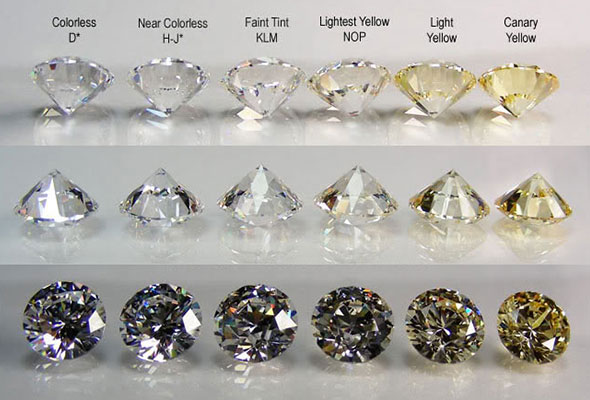DIAMOND CUT
Cut is often considered to be a diamond’s most important factor. It determines what we generally think of as a “sparkle.” Cut grade is an objective measure of a diamond’s light performance. When a diamond is cut with the proper proportions, light is returned out of the top of the diamond, also referred to as the table. If it is cut too shallow, light leaks out of the bottom; too deep and it escapes out of the side.
- Ideal Cut: Reflects nearly all light that enters the diamond
- Very Good Cut: Reflects nearly as much light as the ideal cut
- Good Cut: Reflects most light that enters
- Fair Cut: Still a quality diamond, but less brilliant than a good cut
- Poor Cut: Diamonds with a poor grading generally are cut too deep and narrow/shallow and wide that they lose most of the light out the sides and bottom
Other properties related to a diamond’s cut include light performance, brilliance, fire, polish, and symmetry.
DIAMOND COLOR
After cut, color is generally considered to be the second most important characteristic of a diamond — mainly because the human eye tends to detect a diamond’s sparkle or light performance first and color second. Color manifests itself in a diamond as pale yellow, so a diamond’s true color grade is based on its lack of color. The less color a diamond has, the higher its color grade. A color grade of D is the highest possible, while Z is the lowest grade possible.
- J-I: Near colorless; slightly detectable warmth or tone
- H-G: Near colorless; color is difficult to detect unless compared side-by-side against diamonds of better grades
- F-E: Colorless; minute traces of color can be detected by an expert gemologist
- D: Absolutely colorless; the highest color grade possible.
CLARITY
Clarity is a measure of the number and size of the tiny imperfections that occur in almost all diamonds. Many of these imperfections are microscopic and do not affect a diamond’s beauty in any distinct way.
- FL,IF: Flawless, Internally Flawless; no internal or external imperfections
- VVS1, VVS2: Very, Very Slightly Included; very difficult to see imperfections under 10x magnification
- VS1, VS2: Very Slightly Included; imperfections are not typically visible to the unaided eye
- SI1, SI2: Slightly Included; imperfections are visible under 10x magnification and may be visible to the unaided eye
- I1: Included; minor inclusions that may be visible to the unaided eye

